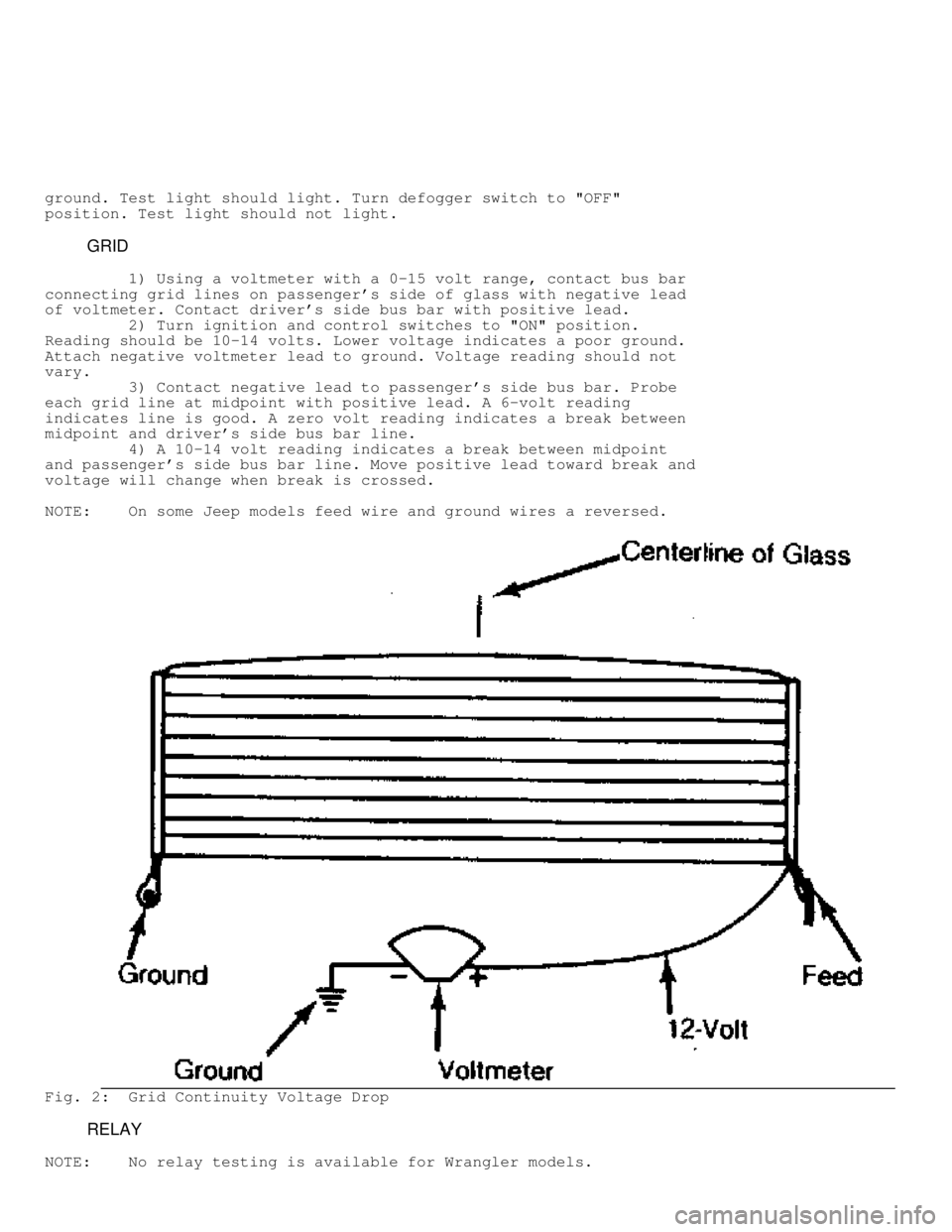1988 JEEP CHEROKEE tow bar
[x] Cancel search: tow barPage 361 of 1378

ground. Test light should light. Turn defogger switch to "OFF"
position. Test light should not light.
GRID
1) Using a voltmeter with a 0-15 volt range, contact bus bar
connecting grid lines on passenger's side of glass with negative lead
of voltmeter. Contact driver's side bus bar with positive lead.
2) Turn ignition and control switches to "ON" position.
Reading should be 10-14 volts. Lower voltage indicates a poor ground.
Attach negative voltmeter lead to ground. Voltage reading should not
vary.
3) Contact negative lead to passenger's side bus bar. Probe
each grid line at midpoint with positive lead. A 6-volt reading
indicates line is good. A zero volt reading indicates a break between
midpoint and driver's side bus bar line.
4) A 10-14 volt reading indicates a break between midpoint
and passenger's side bus bar line. Move positive lead toward break and
voltage will change when break is crossed.
NOTE: On some Jeep models feed wire and ground wires a reversed.
Fig. 2: Grid Continuity Voltage Drop
RELAY
NOTE: No relay testing is available for Wrangler models.
Page 1071 of 1378

TIE ROD ENDS (INNER AND OUTER)
TRACK BARS
TRAILING ARMS
WHEEL BEARINGS, RACES AND SEALS
Wheel Alignment
WHEEL ALIGNMENT
Wheels and Tires
TIRES
VALVE STEMS
WHEEL ATTACHMENT HARDWARE
WHEELS (RIMS)
MOTORIST ASSURANCE PROGRAM (MAP)
OVERVIEW
The Motorist Assurance Program is the consumer outreach
effort of the Automotive Maintenance and Repair Association, Inc.
(AMRA). Participation in the Motorist Assurance Program is drawn from
retailers, suppliers, independent repair facilities, vehicle
manufacturers and industry associations.
Our organization's mission is to strengthen the relationship
between the consumer and the auto repair industry. We produce
materials that give motorists the information and encouragement to
take greater responsibility for their vehicles-through proper,
manufacturer-recommended, maintenance. We encourage participating
service and repair shops (including franchisees and dealers) to adopt
1) a Pledge of Assurance to their Customers and 2) the Motorist
Assurance Program Standards of Service. All participating service
providers have agreed to subscribe to this Pledge and to adhere to the
promulgated Standards of Service demonstrating to their customers that
they are serious about customer satisfaction.
These Standards of Service require that an inspection of the
vehicle's (problem) system be made and the results communicated to the\
customer according to industry standards. Given that the industry did
not have such standards, the Motorist Assurance Program successfully
promulgated industry inspection communication standards in 1994-95 for
the following systems: Exhaust, Brakes, ABS, Steering and Suspension,
Engine Maintenance and Performance, HVAC, and Electrical Systems.
Further, revisions to all of these inspection communication standards
are continually re-published. In addition to these, standards for
Drive Train and Transmissions have recently been promulgated.
Participating shops utilize these Uniform Inspection & Communication
Standards as part of the inspection process and for communicating
their findings to their customers.
The Motorist Assurance Program continues to work
cooperatively and proactively with government agencies and consumer
groups toward solutions that both benefit the customer and are
mutually acceptable to both regulators and industry. We maintain the
belief that industry must retain control over how we conduct our
business, and we must be viewed as part of the solution and not part
of the problem. Meetings with state and other government officials
(and their representatives), concerned with auto repair and/or
consumer protection, are conducted. Feedback from these sessions is
brought back to the association, and the program adjusted as needed.
To assure auto repair customers recourse if they were not
satisfied with a repair transaction, the Motorist Assurance Program
offers mediation and arbitration through MAP/BBB-CARE and other non-
Page 1132 of 1378

TIE ROD ENDS (INNER AND OUTER)
TRACK BARS
TRAILING ARMS
WHEEL BEARINGS, RACES AND SEALS
Wheel Alignment
WHEEL ALIGNMENT
Wheels and Tires
TIRES
VALVE STEMS
WHEEL ATTACHMENT HARDWARE
WHEELS (RIMS)
MOTORIST ASSURANCE PROGRAM (MAP)
OVERVIEW
The Motorist Assurance Program is the consumer outreach
effort of the Automotive Maintenance and Repair Association, Inc.
(AMRA). Participation in the Motorist Assurance Program is drawn from
retailers, suppliers, independent repair facilities, vehicle
manufacturers and industry associations.
Our organization's mission is to strengthen the relationship
between the consumer and the auto repair industry. We produce
materials that give motorists the information and encouragement to
take greater responsibility for their vehicles-through proper,
manufacturer-recommended, maintenance. We encourage participating
service and repair shops (including franchisees and dealers) to adopt
1) a Pledge of Assurance to their Customers and 2) the Motorist
Assurance Program Standards of Service. All participating service
providers have agreed to subscribe to this Pledge and to adhere to the
promulgated Standards of Service demonstrating to their customers that
they are serious about customer satisfaction.
These Standards of Service require that an inspection of the
vehicle's (problem) system be made and the results communicated to the\
customer according to industry standards. Given that the industry did
not have such standards, the Motorist Assurance Program successfully
promulgated industry inspection communication standards in 1994-95 for
the following systems: Exhaust, Brakes, ABS, Steering and Suspension,
Engine Maintenance and Performance, HVAC, and Electrical Systems.
Further, revisions to all of these inspection communication standards
are continually re-published. In addition to these, standards for
Drive Train and Transmissions have recently been promulgated.
Participating shops utilize these Uniform Inspection & Communication
Standards as part of the inspection process and for communicating
their findings to their customers.
The Motorist Assurance Program continues to work
cooperatively and proactively with government agencies and consumer
groups toward solutions that both benefit the customer and are
mutually acceptable to both regulators and industry. We maintain the
belief that industry must retain control over how we conduct our
business, and we must be viewed as part of the solution and not part
of the problem. Meetings with state and other government officials
(and their representatives), concerned with auto repair and/or
consumer protection, are conducted. Feedback from these sessions is
brought back to the association, and the program adjusted as needed.
To assure auto repair customers recourse if they were not
satisfied with a repair transaction, the Motorist Assurance Program
offers mediation and arbitration through MAP/BBB-CARE and other non-